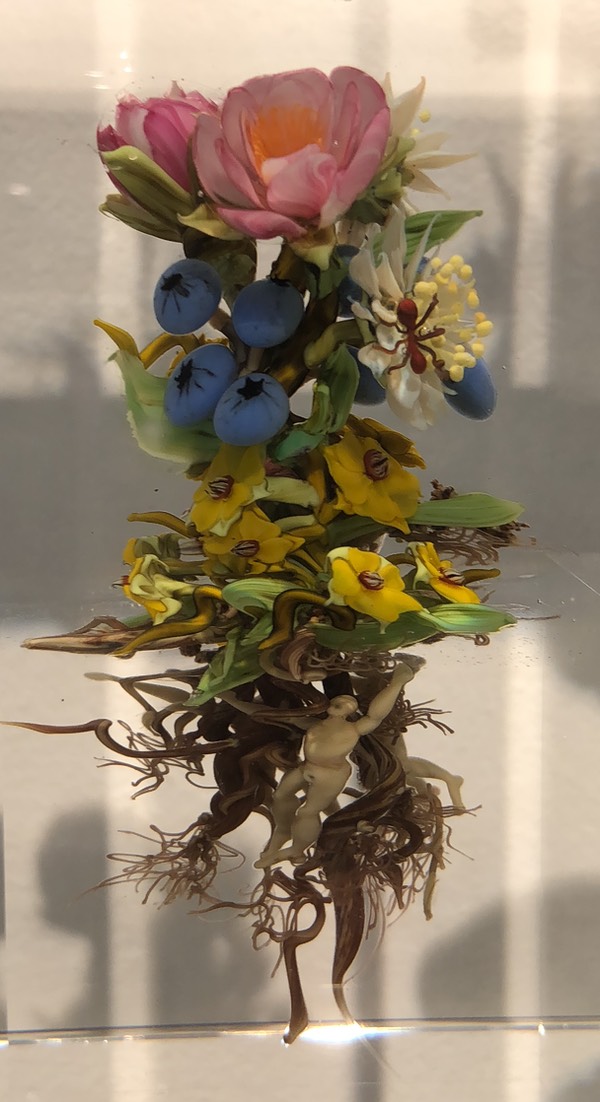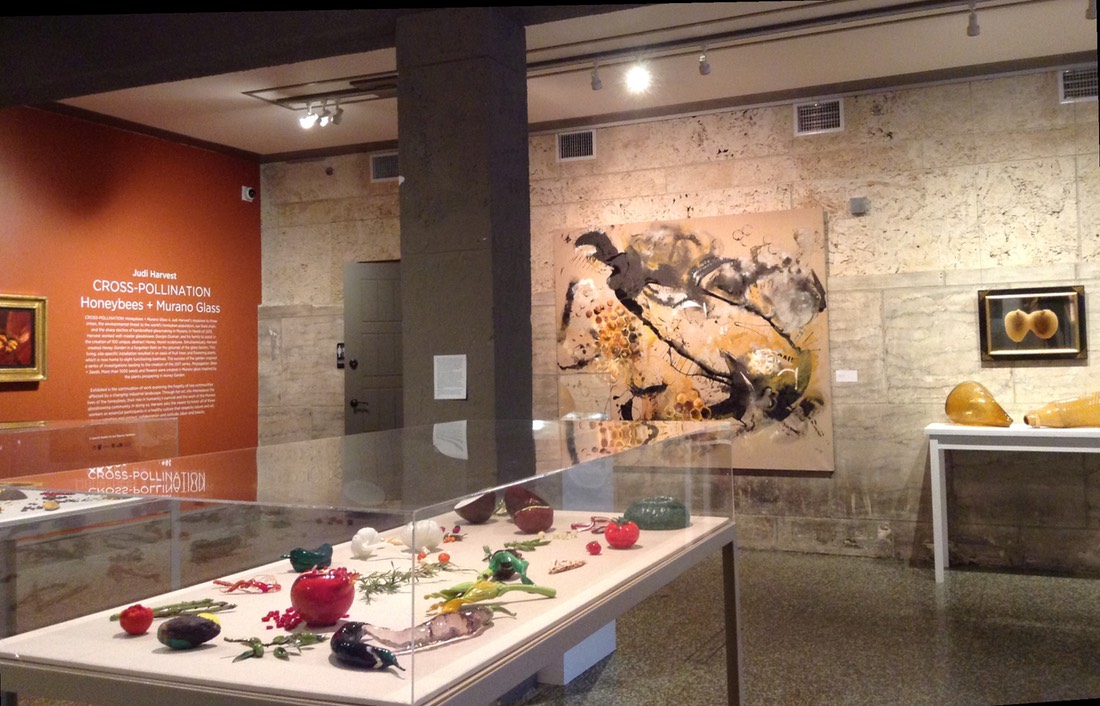This art speaks to the heart. Even when you can see through it.
BY GEORGE FISHMAN
January 28, 2018 01:43 PM
Once Myrna and Sheldon Palley purchased their first glass artwork in Winter Park, they couldn’t stop. “It was just so different from everything else there,” Myrna recalls. One “find” led to another, and 40 years later, the Miami couple continues to collect and share their passion.
The collection has grown exponentially and is now shared with the public in the custom-designed pavilion they donated to the University of Miami’s Lowe Art Museum. Linda Boone, a glass scholar and co-founder of Habatat Galleries, now located in West Palm Beach, organized the Palley Pavilion's inaugural exhibition. She recently oversaw its renovation and curated a new installation to celebrate its 10th anniversary, with lectures, tours and exhibitionsthat are part of the Lowe's “2018: Year of Glass.”
Nearby, at the Coral Gables Museum, artist Judi Harvestshowcases an exhibition of paintings, glass sculptures and video shipped from Venice, Italy, to a space that once housed the city’s fire station and fire truck bays. The result is a haunting display, “Cross-Pollination: Honeybees and Murano Glass,” which pairs the environmental crisis of bee colony collapse with the illustrious, but imperiled, glass studios of Murano.
Both shows marry contemporary technology and centuries-old artisanry to convey potent messages. While Harvest focuses on the fragility of a changing universe, the 75 artists featured at the Lowe use different forms and explore a variety of themes, both delicate and disturbing.
Janusz Walentynowicz,Target at the Palley Glass Pavilion of UM's Lowe Art Museum. Courtesy of Lowe Art Museum.
Director Jill Deupi describes the Lowe’s mission as “exploring contemporary culture through 5,000 years of human creativity. . . . For any art form to be successful – including glass – it needs to speak to heart, hands and mind.”
Boone agrees. “Art shouldn’t be restricted by material or judged by material. It’s all the intent of the artist and how far you can push the possibilities.” A case in point: Janusz Walentynowicz's dark "Target" combines back-painted cast glass faces with welded steel. Its message about gun violence couldn't be more topical — or eloquent — in any other medium.
The Palleys began collecting in the 1960s and '70s, just as American artists ignited a resurgence in glass. “Everyone was sort of working together to try to make something happen,” recalls Boone. It was around that time she co-founded her first gallery, in Michigan, betting on the potential of the "new" medium. “When we started, everything was blown glass because that was the most accessible. " Over the years, artists began to add additional techniques, such as laminating, mosaic assemblage, grinding, casting, acid etching, engraving and plating to their repertory. These introduced a range of effects — such "cut" and "beveled" glass, mirror surfaces, incorporation of photo and typography – plus greater scale. “Artists gained the option to explore image, as well as form,” said Boone.
Paul Stankard, Floral Assemblage Detail at the Palley Glass Pavilion of UM's Lowe Art Museum. Courtesy of Lowe Art Museum.
With the advantage of an early start, the Palleys built an internationally recognized collection that favors quality over quantity. They rely on instinct and intuition, regularly walking through a gallery and usually tagging the same pieces for purchase. But seminars, studio visits and consultation with scholarly dealers like Boone provide important insights. The collection’s “wows” range from intricate miniature florals by Paul Stankard that recall 19th century traditions to the De la Torrebrothers’ “Botanica,” a space-bending image that magically seems to embraces a 3-D glass figure.
Judi Harvest, Cross-Pollination: Honeybees and Murano Glass; installation view courtesy Coral Gables Museum
The collection includes work by many of the era's pioneers, including Dale Chihuly, the acclaimed Washington-state artist whose organic forms grace both gardens and casinos. New at the Lowe is Chihuly's monumental 1998 “Mosaic Persian” sculptural assemblage, commissioned for a stairway by noted New York collectors Dale and Doug Anderson and donated to the museum. Reconfigured by Chuly's studio, it has dramatically transformed the museum lobby.
Boone’s masterful redesign of the Palley Pavilion enhances the exhibition's focus and creates a sense intimacy. She has incorporated loans and donations from other collectors, including a vibrant group of near-life-size polychrome ceramic figures crafted by the late Viola Frey, Robert Arneson's smirking self-portrait head and a striking array of imaginary tribal figures and implements by William Morris (a gift from Miami's Lin Arison).
“This is so important, because most people have no exposure to contemporary glass," said Boone. "Here they can come and really see what's possible.”
Judi Harvest's "Garlic, Zucchini Blossom and Herbs," 2017. Murano glass in assorted techniques. From the show "Cross-Pollination: Honeybees and Murano Glass," at the Coral Gables Museum through May 20, 2018.
Francesco Allegretto
At the Coral Gables Museum, curator Eliza Gonzalez saw “Cross-Pollination” as a natural fit with the city's origins: Founder George Merrick created the ‘The City Beautiful’ on his fruit and vegetable groves, where honeybees pollinated the crops.
Even today, winter-grown Florida produce is disseminated around the country, “and that can’t be done without bees,” Gonzalez said. But the bee population is threatened in part by the sprays used to control mosquitos from spreading diseases.
The irony: "If it kills our bees, it kills agriculture,” she said. Harvest's exhibition explores two threatened universes: that of bees, and that of traditional Murano glass makers now threatened by technology.
Harvest was born in Miami — and so, she said, was the basis for her show. She loves insects and won the ‘smallest pet contest’ in elementary school, she said during a tour. “When Miami is in your DNA, it’s there forever.”
New York and Italy drew her away for art school and career, but life’s fragility and the beauty of nature remain consuming interests. She jumped into the dauntingly complex glass-working field in 1988. “There is a type of ritual and meditation in craftsmanship that translates into creating art, and this makes it spiritual by nature,” she wrote in her exhibition catalog.
During her 30 years of collaboration with Giorgio Giuman’s Murano studio, Harvest witnessed the impact of cheap souvenirs and industrial Chinese production on Venetian traditions as this Murano studio dropped from 75 employees to three. Simultaneously, honeybees were dying from habitat loss and pesticides. The parallel provided an “Aha!” moment.
In defiance of naysayers, in 2013 Harvest salvaged a trash-filled lot in Murano, replacing the refuse with boatloads of dirt to create a garden of flowers, fruit trees — and beehives.
Honeybees – and the fruits of their labors – are the subject of her cross-disciplinary artwork. During the six-month-long Venice Biennale art festival, she organizes exhibitions and symposiums.
Her Coral Gables installation inspires responsible stewardship of nature while celebrating its fragile beauty. Large oil paintings and a monumental hanging beehive sculpture enlarge the world of honeybees to human scale. Three display tables support jewel-like glass pomegranates, tomatoes, olives, herbs, nuts, spices, blossoms, wheat stalks, honeycombs and, of course, bees in lifelike shapes and colors.
By contrast, one table presents exclusively colorless, translucent forms. “This is our future,” Harvest says, referring to the Svalbard Global Seed Vault, a Norwegian-based deep-freeze facility designed to preserve 4.5 million plant varieties against possible extinction.
After 2,000 years in artists' hands, the medium of glass can float, dissolve, sink or sing.

